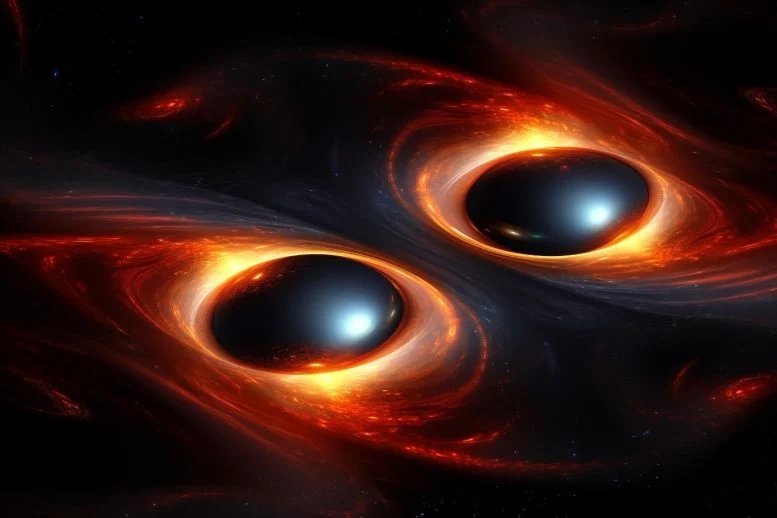 Two colossal black holes slammed together, forming a 225-solar-mass behemoth so extreme it shouldnt exist under current theories. Credit: SciTechDaily.com
Two colossal black holes slammed together, forming a 225-solar-mass behemoth so extreme it shouldnt exist under current theories. Credit: SciTechDaily.com
A gravitational wave has revealed the biggest black-hole merger ever recordedso massive and extreme, it defies current astrophysical models.
The clash formed a 225-solar-mass monster, possibly made from black holes that had already merged before. Einsteins rules may need revisiting.
Record-Breaking Black Hole Collision
The LIGO-Virgo-KAGRA (LVK) Collaboration has observed the most massive black hole merger ever recorded through gravitational waves . Using the LIGO observatories funded by the US National Science Foundation (NSF), scientists detected a signal from a colossal event that created a final black hole roughly 225 times the mass of our Sun. This signal, labeled GW231123, was captured during the LVK networks fourth observing run on November 23, 2023.
LIGO, short for the Laser Interferometer Gravitational-wave Observatory, first made headlines in 2015 by detecting gravitational waves for the very first time. These waves, ripples in the fabric of space-time, were produced by a black hole collision that resulted in a black hole 62 times the mass of the Sun. That groundbreaking signal was picked up by LIGOs two detectors, located in Livingston, Louisiana, and Hanford, Washington.
Following that historic discovery, LIGO joined forces with the Virgo detector in Italy and KAGRA (Kamioka Gravitational Wave Detector) in Japan to form the LVK Collaboration. Together, these instruments have recorded over 200 black hole mergers during their fourth observing run, and approximately 300 in total since their collaborative observations began in 2015.
Shattering Previous Mass Limits
Before now, the most massive black hole mergerproduced by an event that took place in 2021 called GW190521had a total mass of 140 times that of the Sun.
In the more recent GW231123 event, the 225-solar-mass black hole was created by the coalescence of black holes, each approximately 100 and 140 times the mass of the Sun.
In addition to their high masses, the black holes are also rapidly spinning.
This is the most massive black hole binary weve observed through gravitational waves, and it presents a real challenge to our understanding of black hole formation, says Mark Hannam of Cardiff University and a member of the LVK Collaboration. Black holes this massive are forbidden through standard stellar evolution models. One possibility is that the two black holes in this binary formed through earlier mergers of smaller black holes.
Dave Reitze, the executive director of LIGO at Caltech, says, This observation once again demonstrates how gravitational waves are uniquely revealing the fundamental and exotic nature of black holes throughout the universe.
Relativity Tested at Extremes
The high mass and extremely rapid spinning of the black holes in GW231123 push the limits of both gravitational-wave detection technology and current theoretical models. Extracting accurate information from the signal required the use of models that account for the intricate dynamics of highly spinning black holes.
The black holes appear to be spinning very rapidlynear the limit allowed by Einsteins theory of general relativity, explains Charlie Hoy of the University of Portsmouth and a member of the LVK. That makes the signal difficult to model and interpret. Its an excellent case study for pushing forward the development of our theoretical tools.
Researchers are continuing to refine their analysis and improve the models used to interpret such extreme events. It will take years for the community to fully unravel this intricate signal pattern and all its implications, says Gregorio Carullo of the University of Birmingham and a member of the LVK. Despite the most likely explanation remaining a black hole merger, more complex scenarios could be the key to deciphering its unexpected features. Exciting times ahead!
Future of Gravitational-Wave Astronomy
Gravitational-wave detectors such as LIGO, Virgo, and KAGRA are designed to measure minute distortions in space-time caused by violent cosmic events. The fourth observing run began in May 2023, and additional observations from the first half of the run (up to January 2024) will be published later in the summer.
This event pushes our instrumentation and data-analysis capabilities to the edge of whats currently possible, says Sophie Bini, a postdoctoral researcher at Caltech and member of the LVK. Its a powerful example of how much we can learn from gravitational-wave astronomyand how much more there is to uncover.
GW231123 was presented at the 24th International Conference on General Relativity and Gravitation (GR24) and the 16th Edoardo Amaldi Conference on Gravitational Waves held jointly at the GR-Amaldi meeting in Glasgow, Scotland, UK. The calibrated data used to detect and study GW231123 will be made available for other researchers to analyze through the Gravitational Wave Open Science Center (GWOSC).
Never miss a breakthrough: Join the SciTechDaily newsletter.



